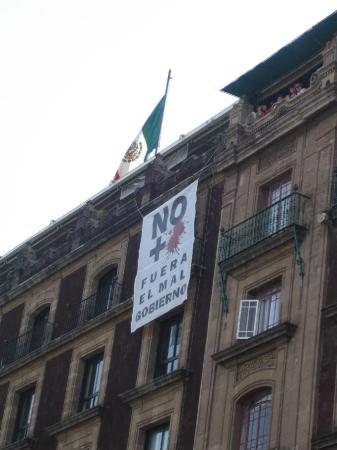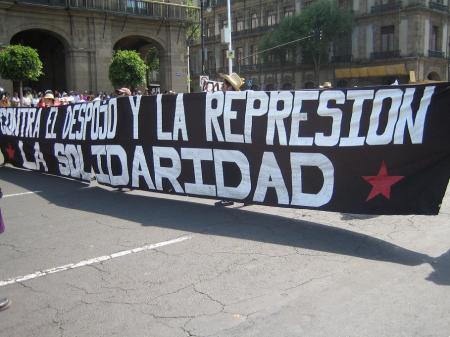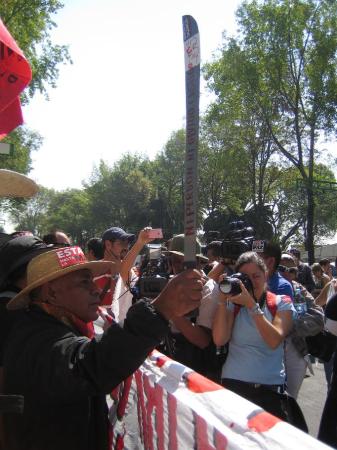| Mexico is caught in the grip of an escalating drug war which has cost 40,000 lives in the past five years and has no end in sight. By comparison, the Zapatista uprising in January 1994, with less than 200 casualties, prompted peace rallies, a speedy ceasefire, and a national dialogue. The body count varies from day to day, 29, 41 or 33, numbers and methods varying as decapitation and mutilation compete with asphyxiation and the traditional bullet in the head. This endless war of unimaginable cruelty has numbed most Mexicans who observe from afar and hope the river of blood doesn’t arrive at their doorstep.Once in a while, however, a single incident can trigger a powerful reaction. The death of Juan Francisco Sicilia, one of seven people gunned down in march, sparked a national mobilisation and a new movement aimed at shifting government policy away from perpetual warfare and toward an integrated political solution to the conflict. Javier Sicilia, poet and father of Juan Francisco, launched ‘The March for Peace with Justice and Dignity’ this month, a three-day event which culminated in a rally in Mexico City. The idea was simple: a silent march and a single slogan, ‘Estamos hasta la madre – no mas sangre‘ (‘We’ve had it up to here, no more bloodshed’). This idea captured the popular imagination and on Sunday, May 8, hundreds of thousands of people marched all over Mexico demanding a radical change to government policy.
In Chiapas, the Zapatista National Liberation Army (EZLN) answered the call and issued a communique in which they announced their plan to march into San Cristobal de las Casas, the town where the Zapatistas first appeared in January 1994. It has been five years since the Zapatistas last mobilised in this manner and for many people the movement has become a fading memory, a noble insurrection which inspired millions but ultimately fizzled out; victims of a sterile and bitter debate over the pitfalls and possibilities of electoral politics.
As Latin America shifted leftwards in the past decade, electing a range of perceived progressive leaders in what has been referred to as the ‘pink tide’, Mexican citizens have waited their turn, hoping that Andres Manuel Lopez Obrador (AMLO) of the opposition Party of the Democratic Revolution (PRD) might fulfill the long awaited dream of leading a decent government.
The Zapatistas publicly rejected AMLO, regarding his electoral platform as a continuation of right wing politics by other means. The PRD leader modified his radical agenda on the campaign trail and sought support from Mexico’s business class. AMLO was once a vocal supporter of the Zapatistas (and still speaks of them with respect), but the breaking point came when the PRD leadership joined the right wing National Action Party (PAN, currently in government) to annul the San Andres Peace Accords (signed in 1996 but never implemented) and approved a diluted version (in 2001) which gutted the original of all its promise. In Chiapas, the situation worsened in recent times when villages affiliated with the PRD attacked Zapatista communities. During the 2006 presidential race, however, many observers viewed the angry exchanges between the PRD and the EZLN as little more than a ‘berrinche barato’ (a childish tantrum) between two macho leaders (Subcomandante Marcos and AMLO) eager to establish themselves as Mexico’s opposition leader.
The return of the Zapatistas to San Cristobal thus acquired a significance far beyond the immediate objective of adding their voice to the popular clamor; it seemed like a reckoning. Could the Zapatistas match the heights of previous years when over 10,000 masked rebels occupied the city, watched by a nervous local elite who pulled the shutters down and held their breath till the indios left?
Over the past five years the Zapatistas have consolidated their autonomous rule across five ‘caracoles’, self-governing councils whose delegates take turns to ‘be the government’, learning the ropes before handing the torch over to another set of delegates from another village. The idea is that many people learn how to ‘be the government’ without giving birth to a professional, bureaucratic political class. In addition the Zapatistas have largely severed ties with visiting NGOs and no longer encourage foreigners to visit their communities. The spectacle of hundreds of outsiders trekking in to jungle communities, keen to learn how to make revolution happen, left a damaging imprint in rebel territory. While visitors came in good faith and for a time at least served as an important buffer against army and paramilitary forces between 1995-99, they also disrupted daily life and generated inequalities as gifts were dispensed and money left behind, fueling jealousy and protagonism.
When the afternoon of May 7 arrived, San Cristobal was drenched in warm sunshine and an air of expectancy filled the main square where TV crews jostled for position in front of an improvised stage. The Zapatistas arrived in a long winding trail of men and women of all ages, each one wearing a ski mask which bore a number representing the caracol or government council from which they came. The square quickly filled to overflowing and word came through that the same number again were leaving the assembly point on the edge of town. By the time the Zapatista comandantes opened the event with the national anthem, the rebels had already won a major victory by organising the biggest march this city has ever seen. An estimated 20,000 rebels were present, bringing with them the fragrant aroma of distant communities, of corn and woodsmoke and that most elusive element, community cohesion, described by one analyst as “the sacred fire of the movement.”
The effort required to get that many rebels to San Cristobal was enormous as each community was in charge of its own transport and food at a time when corn, rice and beans are scarce. In addition, the Zapatistas seem destined to pay a high price for their audacity and this weekend was no exception; a young Zapatista was struck and killed by a vehicle en route to the march while an 8-month-old baby died of suffocation in an overcrowded truck.
The Zapatistas have an ambivalent relationship with the rest of Mexico; Here we are, their silence seems to say, we have territory and self-rule in our small corner of the country, what have you done? The images of Javier Sicilia, a lone individual leading the march of the indignant and the impotent in Mexico City, contrasted sharply with the collective effort that is Zapatismo. The rebels moved as one, arriving and leaving in formation, sharing transport and territory. This sense of cohesion is amplified by the shared ‘means of production’; the milpa (cornfield) which forms the basis for survival across regional and linguistic boundaries. The situation is fragile as the Zapatista communities struggle to make ends meet and withstand the twin pressures of army/paramilitary aggression and state handouts that tempt rebels away from the Zapatista ranks. The 30 comandantes of the Clandestine Indigenous Revolutionary Committee (CCRI) who formed a guard of honor up front on the stage, melted effortlessly into the crowd, their faces unknown, their words attributable to no one in particular.
Meanwhile in Mexico City, at least 70 victims of violence took turns to speak out, including Patricia Duarte whose infant son was burned to death in a creche in Sonora, along with 47 other children. In Mexico today, the term insecurity has a broad meaning which covers the village of San Juan Copala, Oaxaca, forced to flee en masse due to state-sponsored violence, and the parents of those who died in the creche, who also await justice. San Juan Copala committed the fatal error of declaring itself an autonomous zone, Zapatista style, but unlike the Chiapan rebels they had no weapons to back up their claims.
Mexican President Felipe Calderon delivered a televised address in response to the peace march in which he equated the call for an end to state violence with a surrender to the drug cartels. “We have might, right and the law on our side,” said Calderon, adopting a belligerent tone, insisting that the army would remain on the streets and at the centre of his national security strategy.
In a report released on May 10 Amnesty International accused Mexican security forces of torture, disappearances and murder, including charges of passing off innocent victims of army violence as members of drug gangs. Amnesty also criticised Mexico’s justice system for failing to charge a single member of the armed forces with criminal activity, despite dozens of well documented cases.
“We are not trying to overthrow the government,” commented Juan Sicilia, responding to Calderon, “we want to rebuild the social fabric of this nation.” Sicilia added that the Mexican people were paying an intolerable price for an unwinnable war which no one asked for, the course of which is determined by politicians “in upmarket restaurants and offices paid for by us.” By the end of the three-day march Sicilia’s tone had hardened, recognising perhaps that the Calderon administration had no intention of paying him any heed. Sicilia called for civil disobedience should the government ignore their demands.”It takes balls to strike back, to refuse to pay taxes and it will take all of us to surround parliament until our demands are heard,”‘ he said. A decade ago this reporter first noticed Sicilia when he used to finish his weekly column in Proceso magazine with the following tag, regardless of the topic under discussion: ‘In addition I believe that the San Andres (Zapatista) Peace Accords should be implemented.’
Sicilia has launched an important citizen initiative which is gathering momentum and which has no affiliation with Mexico’s discredited political parties. In 2006 the EZLN launched ‘la otra campana,’ the other campaign, an attempt to build a popular movement which would eschew electoral timetables and challenge the state from below. If there is one lesson learned since 1994, however, it is that the Zapatistas cannot carry the burden of hope alone and that the rest of Mexico must do its own share of the heavy lifting. “We know you didn’t understand anything,” joked one Zapatista delegate in San Cristobal, referring to the translation of each speech into several indigenous languages, “but that’s the way it goes, you just had to put up with us. Thank you for your patience.”
The Zapatistas remain the ever patient outsiders in a country torn apart by violence and corruption, quietly building an autonomous alternative, a living example of what a disciplined, long-term struggle can achieve. “You are not alone,” said Comandante David, addressing vicitims of violence throughout Mexico during the rally. The Zapatistas have been alone for too long, derided for lacking ‘common sense’ and refusing to throw their weight behind the lesser of three evils at election time. With just a brief hour in the limelight Javier Sicilia has already come to the conclusion that if Mexico’s political system fails to respond to the current crisis of representation and if a sweeping new security law is approved, the 2012 presidential elections shall be a pointless exercise in which a candidate bound and gagged by institutional corruption will be elected to lead a nation edging dangerously close to a politico-military dictatorship.
|








